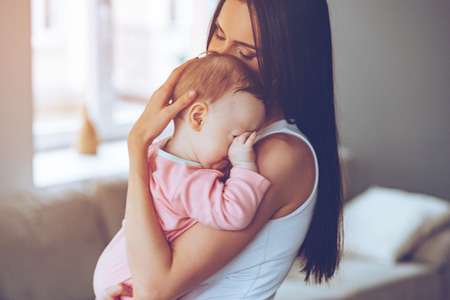The Bunk About Bonding

Page 1
The Bunk About Bonding
With stitches in the perineum and hemorrhoids rampant, postpartum moms have enough to worry about. But two Australian chaps inadvertently gave new mothers another hurdle. Researchers Marshall Klaus and John Kennell coined the term bonding in the 1970s to describe a phenomenon in which mothers who had skin-to-skin contact with their babies 30-60 minutes after birth experienced a "specially sensitive state which made them unusually ready to 'fall in love' with their child."Subsequent research has not confirmed the physiologic state Klaus and Kennell described. Yet, we know that touching and massaging a newborn stimulates breathing, that a mother's heartbeat can quiet an infant used to the uterine environment, and nipple contact stimulates the release of oxytocin, the so-called "cuddle hormone" that helps contract the uterus and inhibit bleeding. Undoubtedly, there is a synchronized dance of physiology that takes place in a mom's and baby's reactions to one another.
Bonding is a trust built between a needy baby and a responsive caretaker, over repetition of "crying" and "soothing" episodes. Somehow though, "bonding" became an all-encompassing term, the buzz word for the entire relationship between mother and child. We use the term to describe an ethereal connection we feel with our young, evidence of the maternal instinct at work. This little cocktail of bonding and instinct makes "the perfect mother."
Bonding with a Capital "B"
Bonding becomes too big for its britches when it's used interchangeably with "attachment," a broader scientific term that describes the affection between a child and his caretaker that propels him to healthy, emotionally balanced adulthood. Although attachment difficulties are most commonly identified in adoption and foster care systems, the reason many moms quit jobs and stay at home and many more fret that they can't is to establish connections during the first eighteen months of a child's life that they believe will be of lifelong value.
Yet, as Carin Rubenstein notes in her book The Sacrificial Mother: Escaping the Trap of Self-Denial, psychology's dirty little secret is that there is no real proof this early and all-important connection exists. Even if it does exist, science hasn't shown that this connection has anything to do with how well-adjusted or sociable a child is later in life.
Indeed, we know that genes have the greatest influence over a child's future personality. Social circumstances also have an impact, such as being born and growing up poor, or experiencing a frequent number of divorces or moves during childhood. Contrary to what many of us believe about the decisive influence of the parent-infant relationship, studies of identical twins who were adopted at birth and raised by different mothers and fathers demonstrate that no matter who raises them, identical twins grow up to be uncannily similar.
Am I Bonding Correctly?
The moms I know are terribly confused and have very different definitions of bonding. Some moms meant it literally, as in the "immediate inclination to mother." A good portion of moms felt this sensation even while they were pregnant, perhaps fueling their nesting instinct. Other moms felt a profound bond when they first held their babies and said it seemed as if they were "born to do this."
Others, though, felt bonding was a decision that at some point they consciously chose to let themselves fall head over heels for the wrinkled bundle in their arms. And a couple of moms believed that bonding was a hoax. They didn't accept it as a postpartum milestone, much less a litmus test of good mothering.
Despite our varied definitions, many of us expect baby love and the ability to mother to arise from the mist, in the same romantic way described in InStyle and other magazines' celebrity mom profiles. Jane Seymour, Reese Witherspoon, Christie Brinkley, and Jada Pinkett Smith welcomed us into their Malibu mansions and Hamptons hideaways to see how babies had met their deepest yearnings for happiness. As mommies, they were thin and radiant in nurseries with hand-painted murals or at catered showers attended by Hollywood's glitterati of childbearing years. Literally and figuratively, they shared recipes so we could be just like them, only without a staff of nannies, personal chefs, and trainers.
Logically then, in our postpartum haze, we wonder where our expected bliss has gone. We fail to recognize what psychiatrists know very well: Many people initially respond to intense feelings by distancing themselves.
If our bliss is mitigated by fear, or goes underground while we sort out the enormity of love we feel, we think we don't have the right stuff for motherhood. We worry, can our babies tell that our whole hearts are sometimes not in it? And, if we hold our infants and toddlers close but don't experience a giddy tingle inside, does it mean bonding is doomed?